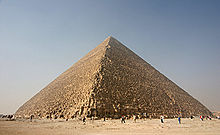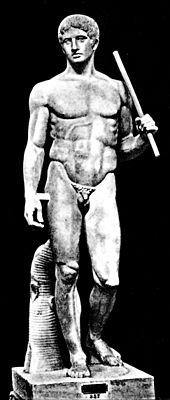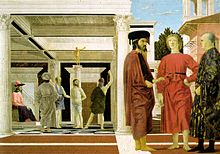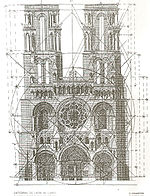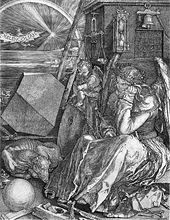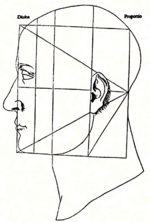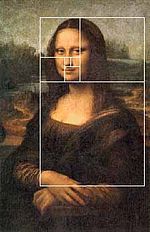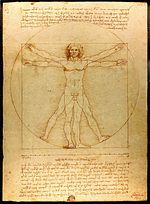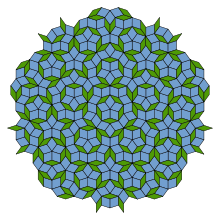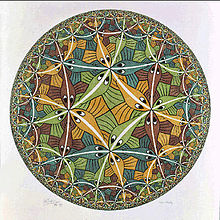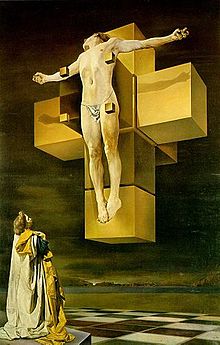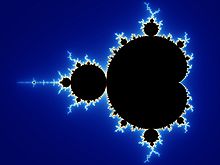- Mathematics and art
-
Mathematics and art have a long historical relationship. The ancient Egyptians and ancient Greeks knew about the golden ratio, regarded as an aesthetically pleasing ratio, and incorporated it into the design of monuments including the Great Pyramid,[1] the Parthenon, the Colosseum. There are many examples of artists who have been inspired by mathematics and studied mathematics as a means of complementing their works. The Greek sculptor Polykleitos prescribed a series of mathematical proportions for carving the ideal male nude. Renaissance painters turned to mathematics and many, including Piero della Francesca, became accomplished mathematicians themselves.
Contents
Overview
Galileo Galilei in his Il Saggiatore wrote that “[The universe] is written in the language of mathematics, and its characters are triangles, circles, and other geometric figures.”[2] Artists who strive and seek to study nature must therefore first fully understand mathematics. On the other hand, mathematicians have sought to interpret and analyse art through the lens of geometry and rationality.
Ancient times
The Golden Ratio
The Golden Ratio, roughly equal to 1.618, was first formally introduced in text by Greek mathematician Pythagoras and later by Euclid in the 5th century BC. In the fourth century BC, Aristotle noted its aesthetic properties.[3] Aside from interesting mathematical properties, geometric shapes derived from the golden ratio, such as the golden rectangle, the golden triangle, and Kepler’s triangle, were believed to be aesthetically pleasing. As such, many works of ancient art exhibit and incorporate the golden ratio in their design. Various authors can discern the presence of the golden ratio in Egyptian, Summerian and Greek vases, Chinese pottery, Olmec sculptures, and Cretan and Mycenaean products from as early as the late Bronze Age.[4] The prevalence of this special number in art and architecture even before its formal discovery by Pythagoras is perhaps evidence of an instinctive and primal human cognitive preference for the golden ratio.[5]
Pyramids
Evidence of mathematical influences in art is present in the Great Pyramids, built by Egyptian Pharaoh Khufu and completed in 2560BC. Pyramidologists since the nineteenth century have noted the presence of the golden ratio in the design of the ancient monuments. They note that the length of the base edges range from 755–756 feet while the height of the structure is 481.4 feet. Working out the math, the perpendicular bisector of the side of the pyramid comes out to 612 feet.[6] If we divide the slant height of the pyramid by half its base length, we get a ratio of 1.619, less than 1% from the golden ratio. This would also indicate that half the cross-section of the Khufu’s pyramid is in fact a Kepler’s triangle. Debate has broken out between prominent pyramidologists, including Temple Bell, Michael Rice, and John Taylor, over whether the presence of the golden ratio in the pyramids is due to design or chance. Of note, Rice contends that experts of Egyptian architecture have argued that ancient Egyptian architects have long known about the existence of the golden ratio. In addition, three other pyramidologists, Martin Gardner, Herbert Turnbull, and David Burton contend that:
Herodotus related in one passage that the Egyptian priests told him that the dimensions of the Great Pyramid were so chosen that the area of a square whose side was the height of the great pyramid equaled the area of the triangle.[7]
This passage, if true, would undeniably prove the intentional presence of the golden ratio in the pyramids. However, the validity of this assertion is found to be questionable.[8] Critics of this golden ratio theory note that it is far more likely that the original Egyptian architects modeled the pyramid after the 3-4-5 triangle, rather than the Kepler’s triangle. According to the Rhind Mathematical Papyrus, an ancient papyrus that is the best example of Egyptian math dating back to the Second Intermediate Period of Egypt, the Egyptians certainly knew about and used the 3-4-5 triangle extensively in mathematics and architecture. While Kepler’s triangle has a face angle of 51°49’, the 3-4-5 triangle has a face angle of 53°8’, very close to the Kepler’s triangle.[9] Another triangle that is close is one whose perimeter is 2π the height such that the base to hypotenuse ratio is 1:4/π. With a face angle of 51°50’, it is also very similar to Kepler’s triangle. While the exact triangle the Egyptians chose to design their pyramids after remains unclear, the fact that the dimensions of pyramids correspond so strongly to a special right triangle suggest a strong mathematical influence in the last standing ancient wonder.
Parthenon
The Parthenon is a temple dedicated the Greek goddess Athena, built in the 5th century BC on the Athenian Acropolis. It is contended that Phidias, the main Greek sculptor in charge of decorating the Parthenon, also knew about the golden ratio and its aesthetic properties. In fact, the Greek symbol for the Golden Ratio is named Phi (φ) because of Phidias.[10] The golden rectangle, a rectangle whose length to width ratio is the golden ratio and considered the most pleasing to the eye, is almost omnipresent in the façade and floor plans of the Parthenon. The entire façade may be enclosed within a golden rectangle.[11] The ratio of the length of a metope and triglyph to the height of the frieze, as well as the height of the columns and stylobate to the entire height of the temple is also the golden ratio. Phidias himself constructed many Parthenon statues that meticulously embody the golden ratio.[12] Phidias is also notable for his contributions to the Athena Parthenos and the Statue of Zeus. As with the Pyramids however, more recent historians challenge the purposeful inclusion of the golden ratio in Greek temples, such as the Parthenon, contending that earlier studies have purposefully fitted in measurements of the temple until it conformed to a golden rectangle.
Great Mosque of Kairouan
The Great Mosque of Kairouan was built by Uqba ibn Nafi in 670 A.D. in modern day Tunisia. Today, it exists as the first mosque in North Africa, as well as the most famous one. Boussora and Mazouz’s study of the mosque dimensions reveal a very consistent application of the golden ratio in the mosque’s design. Boussora and Mazouz contend:
The geometric technique of construction of the golden section seems to have determined the major decisions of the spatial organisation. The golden section appears repeatedly in some part of the building measurements. It is found in the overall proportion of the plan and in the dimensioning of the prayer space, the court and the minaret. The existence of the golden section in some parts of Kairouan mosque indicates that the elements designed and generated with this principle may have been realised at the same period.[13]
It should however be noted that the current floor plans of the mosque do not constitute a perfect rectangle, due to urban constraints. Even so, for example, the division of the court yard and prayer hall is almost a perfect golden ratio.
Polykleitos
Polykleitos the Elder (c.450-420B.C.) was a Greek sculptor from the school of Argos who was also a contemporary of Phidias. His works and statues consisted mainly of bronze and were of athletes. According to the mathematician Xenocrates, Polykleitos is ranked as one of the most important sculptors of Classical antiquity for his work on the Doryphorus and the statue of Hera in the Heraion of Argos.[14] While his sculptures may not be as famous as those Phidias, he is better known for his approach towards sculpture. In the Canon of Polykleitos, a treatise he wrote designed to document the “perfect” anatomical proportions of the male nude, Polykleitos gives us a mathematical approach towards sculpturing the human body. The influence of the Canon of Polykleitos is immense both in Classical Greek, Roman, and Renaissance sculpture, with many sculptors after him following Polykleitos’ prescription. While none of Polykleitos’ original works survive, Roman copies of his works demonstrate and embody his ideal of physical perfection and mathematical precision.
Some scholars contend the influence of the mathematician Pythagoras on the Canon of Polykleitos.[15] The Canon applies the basic mathematical concepts of Greek geometry, such as the ratio, proportion, and symmetria (Greek for “harmonious proportions”) and turns it into a system capable of describing the human form through a series of continuous geometric progressions. Polykleitos starts with a specific human body part, the distal phalanges of the little finger, or the tip of the little finger to the first joint, and establishes that as the basic module or unit for determining all the other proportions of the human body.[16] From that, Polykleitos multiplies the length by radical 2 (1.14142) to get the distance of the second phalanges and multiplies the length again by radical 2 to get the length of the third phalanges. Next, he takes the finger length and multiplies it again by radical 2 to get the length of the palm from the base of the finger to the ulna. This geometric series of measurements progress until Polykleitos has formed the arm, chest, body, and so on. Other proportions are less set. For example, the ideal body should be 8 heads high and 2 heads wide. However, ordinary figures are 7½ heads tall while heroic figures are 8½ heads tall.
Renaissance
The Renaissance saw a rebirth of Classical Greek and Roman culture and ideas, among them the study of mathematics as a relevant subject needed to understand nature and the arts. Two major reasons drove Renaissance artists towards the pursuit of mathematics. First, painters needed to figure out how to depict three-dimensional scenes on a two-dimensional canvas. Second, philosophers and artists alike were convinced that mathematics was the true essence of the physical world and that the entire universe, including the arts, could be explained in geometric terms.[17] In light of these factors, Renaissance artists became some of the best applied mathematicians of their times.
Paolo Uccello
Italian painter Paolo Uccello (1397–1475) was fascinated by the study of perspective. A marble mosaic in the floor of the San Marco Basilica in Venice featuring the small stellated dodecahedron is attributed to Uccello.[18]
Piero della Francesca
Piero della Francesca (c.1415-1492), an early Renaissance artist from Italy, exemplified this new shift in Renaissance thinking. Though chiefly appreciated for his art, he was an expert mathematician and geometer and authored many books on solid geometry and the emerging field of perspective, including De Prospectiva Pingendi (On Perspective for Painting), Trattato d’Abaco (Abacus Treatise), and De corporibus regularibus (Regular Solids).[19][20][21] Historian Vasari in the Lives of the Painters calls Piero the “greatest geometer of his time, or perhaps of any time.”[22] He was deeply interested in the theoretical study of perspective and this was apparent in many of his paintings, including the S. Agostino altarpiece and The Flagellation of Christ. His work on geometry influenced later mathematicians and artists, including Luca Pacioli in his De Divina Proportione and Leonardo da Vinci.
Piero began his study of classical mathematics and the works of the Greek mathematician Archimedes in the library at Urbino.[23] In addition to this classical training, Piero was taught commercial arithmetic in “abacus schools,” evidenced indirectly by his own writings which copies the format of abacus school textbooks.[24] It is possible therefore that he was influenced by the works of Leonardo Pisano (Fibonacci) from which those abacus textbooks were derived. Piero lived in the time when linear perspective was just being introduced in the artistic world. Leon Battista Alberti sums up the idea: “light rays travel in straight lines from points in the observed scene to the eye, forming a kind of pyramid with the eye as vertex.”[25] The painting therefore is a cross-sectional plane of that pyramid. The study of perspective precedes Piero and the Renaissance however. Before perspective, artists typically sized objects and figures according to their thematic importance. Perspective was first observed in 5th century B.C. Greece and Euclid’s Optics first introduced a mathematical theory of perspective. Muslim mathematician Alhazen extended the theory of optics in his Book of Optics in 1021 A.D., although he never applied these principals to art. Perspective first exploded onto the Renaissance artistic scene with Giotto di Bondone, who attempted to draw in perspective using an algebraic method to determine the placement of distant lines. In 1415, Italian architect Filippo Brunelleschi and his friend Leon Battista Alberti demonstrated the geometrical method of applying perspective in Florence, centered around the usage of similar triangles, a mathematical concept formulated long ago by Euclid, in determining the apparent height of distant objects.[26] However, Piero is the first painter to write a practical treatise for the application of this idea in art in his De Prospectiva Pingendi.
In De Prospectiva Pingendi, Peiro painstakingly transforms art and his empirical observations into “vera scientia” (true science), i.e. into mathematical proofs. His treatise starts like any mathematics book in the vein of Euclid: he defines the point as “essere una costa tanto picholina quanto e possible ad ochio comprendere” (being the tiniest thing that is possible for the eye to comprehend).[17] From there, Piero uses a series of deductive logic to lead us, theorem by theorem, to the perspective representation of a three-dimensional body. Piero realized that the way aspects of a figure changed with the point of view obeyed precise and determinable mathematical laws. Piero methodically presented a series of perspective problems to gradually ease his reader from easy to increasingly complex problems. Mark Peterson explains:
In Book I, after some elementary constructions to introduce the idea of the apparent size of an object being actually its angle subtended at the eye, and referring to Euclid's Elements Books I and VI, and Euclid's Optics, he turns, in Proposition 13, to the representation of a square lying flat on the ground in front of the viewer. What should the artist actually draw? After this, objects are constructed in the square (tilings, for example, to represent a tiled floor), and corresponding objects are constructed in perspective; in Book II prisms are erected over these planar objects, to represent houses, columns, etc.; but the basis of the method is the original square, from which everything else follows.[27]
Notre Dame
In his 1919 book Ad Quadratum, Frederik Macody Lund, a historian who studied the geometry of several gothic structures, claims that the Cathedral of Chartres (begun in the 12th century), the Notre-Dame of Laon (1157–1205), and the Notre Dame de Paris (1160) are designed according to the golden ratio.[28] According to Macody Lund, the superimposed regulator lines show that the cathedral has golden proportions. Other scholars argue that until Pacioli's 1509 publication, the golden ratio was unknown to artists and architects.[29]
Albrecht Dürer
Albrecht Dürer (1471–1528) was a German Renaissance printmaker who made important contributions to polyhedral literature in his book, Underweysung der Messung (Four Books on Measurement) (1525), meant to teach the subjects of linear perspective, geometry in architecture, Platonic solids, and regular polygons. Dürer was likely influenced by the works of Luca Pacioli and Piero della Francesca during his trips to Italy.[30] While the examples of perspective in Underweysung der Messung are underdeveloped and contain a number of inaccuracies, the manual does contain a very interesting discussion of polyhedral. Dürer is also the first to introduce in text the idea of polyhedral nets, polyhedral unfolded to lie flat for printing.[31] Dürer published another influential book on human proportions called Vier Bücher von Menschlicher Proportion (Four Books on Human Proportion) in 1528.
Dürer's well-known engraving Melancholia I depicts a frustrated thinker sitting by what is best interpreted as a “truncated rhomboid” or a “rhombohedron with 72-degree face angles, which has been truncated so it can be inscribed in a sphere”.[32] It has been the subject of more modern interpretation than almost any other print,[33] including a two-volume book by Peter-Klaus Schuster,[34] and a very influential discussion in Erwin Panofsky's monograph of Dürer.[35] One might speculate that the cube represents masculinity and truncating one in an upright position may have some Freudian symbolism.
De Divina Proportione
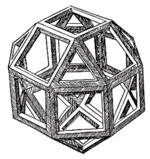 The first printed illustration of a rhombicuboctahedron, by Leonardo da Vinci, published in De divina proportione.
The first printed illustration of a rhombicuboctahedron, by Leonardo da Vinci, published in De divina proportione.
Written by Luca Pacioli in Milan from 1496–98, published in Venice in 1509, De Divina Proportione was about mathematical and artistic proportion. Leonardo da Vinci drew illustrations of regular solids in De divina proportione while he lived with and took mathematics lessons from Pacioli. Leonardo's drawings are probably the first illustrations of skeletonic solids, which allowed an easy distinction between front and back.[36] Skeletonic solids, such as the rhombicuboctahedron, were one of the first solids drawn to demonstrate perspective by being overlaid on top of each other. Additionally, the work also discusses the use of perspective by painters such as Piero della Francesca, Melozzo da Forlì, and Marco Palmezzano.
It is in De Divina Proportione that the golden ratio is defined as the divine proportion. Pacioli also details the use of the golden ratio as the mathematical definition of beauty when applied to the human face.
“The Ancients, having taken into consideration the rigorous construction of the human body, elaborated all their works, as especially their holy temples, according to these proportions; for they found here the two principal figures without which no project is possible: the perfection of the circle, the principle of all regular bodies, and the equilateral square.” from De Divina Proportione (1509)
Da Vinci
Leonardo da Vinci (1452–1519) was an Italian scientist, mathematician, engineer, inventor, anatomist, painter, sculptor, and architect. Leonardo has often been described as the archetype of the Renaissance man.[37][38]
Renowned primarily as a painter, Leonardo incorporated many mathematical concepts into his artwork despite never having received any formal mathematical training. It was not until the 1490s that he trained under Luca Pacioli and prepared a series of drawings for De Divina Proportione. Leonardo studied Pacioli's Summa, from which he copied tables of proportions and multiplication tables.[39]
Notably in Mona Lisa and The Last Supper, Leonardo’s work incorporated the concept of linear perspective. By making all of the lines in the painting converge on a single, invisible point on the horizon, a flat painting can appear to have depth. In creating the vanishing point, Leonardo creates the illusion that the painting is an extension of the room itself.[40]
In Mona Lisa, one can observe the mismatch between the left and right backgrounds which creates the illusion of perspective and depth. It is believed that Leonardo, as a mathematician, purposefully made this painting line up with Golden Rectangles in this fashion in order to further the incorporation of mathematics into art. A Golden Rectangle whose base extends from her right wrist to her left elbow and reaches the top of her very head can be constructed. This Golden Rectangle can be then further subdivided into smaller Golden Rectangles and can be drawn to produce the Golden Spiral. Also a viewer can note that all these edges of the new rectangles come to intersect the focal points of Mona Lisa: chin, eye, nose, and upturned corner of her mouth. It is also worth mentioning that the overall shape of the woman is a triangle with her arms as the base and her head as the tip. This is meant to draw attention to the face of the woman in the portrait.[41]
In The Last Supper, Leonardo sought to create a perfect harmonic balance between the placement of the characters and the background. He did intensive studies on how the characters should be arranged at the table. The entire painting was constructed in a tight ratio of 12:6:4:3.[42] The entire piece measures 6 by 12 units. The wall in the back is equal to 4 units. The windows are 3 units and the recession of the tapestries on the side walls is 12:6:4:3.[43]
In Vitruvian Man, Leonardo used both image and text to express the ideas and theories of Vitruvius, a first century Roman architect and author of De Architectura libri X.[44] The Vitruvian ideas formed the basis of Renaissance proportion theories in art and architecture. Various artists and architects had illustrated Vitruvius' theory prior to Leonardo, but Leonardo's drawing differs from the previous works in that the male figure adopts two different positions within the same image. He is simultaneously within the circle and the square; movement and liveliness are suggested by the figure's active arms and legs.
The thin lines on his form show the significant points of the proportion scheme. These lines indicate Leonardo’s concern with the architectural meaning of the work. Leonardo is representing the body as a building and illustrating Renaissance theory which linked the proportions of the human body with architectural planning.
Industrial and modern times
Penrose tiles
Named after Roger Penrose, Penrose tiles are nonperiodic tiles generated from a simple base tile. In its simplest form, it consists of 36- and 72-degree rhombuses, with "matching rules" forcing the rhombuses to line up against each other only in certain patterns.[45] Penrose tiles lack translational symmetry due to its nonperiodicity, and any finite region in a tiling appears infinitely many times in the tiling.[46]
Both visually complex and simple at the same time, Penrose tiles arise from basic mathematical principles and can be viewed as intricately related to the golden ratio. Two notable relationships between Penrose tiles and the Golden ratio are:
- The ratio of thick to thin rhombuses in the infinite tile is the golden ratio 1.618.
- The distances between repeated patterns in the tiling grow as Fibonacci numbers when the size of the repetition increases.
Eden Project
Located near St. Austell in Southwestern England, the Eden Project has intricate greenhouses composed of geodesic domes (also known as biomes). Known to many as a visitor attraction with the world’s largest greenhouse, the Eden Project is a dedication to preserving nature and the mathematics embedded in nature’s design.[47] Throughout the center visitors can notice intricate patterning of pentagons and hexagons that form unique architectural structures mimicking nature’s simple and complex shapes. Additionally, the Eden Project biomes house plant species from around the world with each honeycomb like dome emulating a natural environment.
The Core, a new education building, was constructed with the inspiration of the Fibonacci Numbers and plant spirals. From a top down view, one can see the building’s windows aligned in a spiral similar to the golden spiral and plant spirals.[48]
California Polytechnic State University
Like many college campuses throughout the country trying to inspire its students, the Engineering Plaza of California Polytechnic State University was designed to incorporate the Fibonacci sequence and golden spiral. Campus buildings were designed around the concept of the golden spiral which is defined at the very center by the three core buildings. The outward spiraling arc can be seen below and extends throughout the campus.[49]
M.C. Escher
A renowned artist born in 1898 and died in 1972, M.C. Escher was known for his mathematically inspired work.[50] Escher’s interest in tessellations, polyhedrons, shaping of space, and self-reference manifested itself in his work throughout his career.[51] In the Alhambra Sketch, Escher showed that art can be created with polygons or regular shapes such as triangles, squares, and hexagons. Escher used irregular polygons when tiling the plane and often used reflections, glide reflections, and translations to obtain many more patterns. Additionally, Escher arranged the shapes to simulate images of animals and other figures. His work can be noted in Development 1 and Cycles.
Escher’s was also interested in a specific type of polyhedron that appears many times in his work. These polyhedrons are defined as solids that have exactly similar polygonal faces, also known as Platonic solids. These Platonic solids, tetrahedrons, cubes, octahedrons, dodecahedrons, and icosahedrons stellations are especially prominent in Order and Chaos and Four Regular Solids.[52] Here these stellated figures often reside within another figure which further distorts the viewing angle and conformation of the polyhedrons and providing a multifaceted perspective artwork.[53] Additionally, Escher worked with the shape and logic of space in Three Intersecting Planes, Snakes, High and Low, and Waterfall.
Many of Escher's works contain impossible constructions, made using geometrical objects that cannot exist but are pleasant to the human sight. Some of Escher's tessellation drawings were inspired by conversations with the mathematician H. S. M. Coxeter concerning hyperbolic geometry.[54] Relationships between the works of mathematician Kurt Gödel, artist M. C. Escher and composer Johann Sebastian Bach are explored in Gödel, Escher, Bach, a Pulitzer Prize-winning book.
Salvador Dali
Salvador Dalí (1904–1989) incorporated mathematical themes in several of his later works. His 1954 painting Crucifixion (Corpus Hypercubus) depicts a crucified figure upon the net of a hypercube. In The Sacrament of the Last Supper (1955) Christ and his disciples are pictured inside a giant dodecahedron. Dali's last painting, The Swallow's Tail (1983), was part of a series inspired by René Thom's catastrophe theory.
Pablo Palazuelo
Pablo Palazuelo (1969–2007) was a contemporary Spanish painter and sculptor focused on the investigation of form. Heavily influenced by cubism and Paul Klee, Palazuelo developed a unique style that he described as the geometry of life and the geometry of all nature. Consisting of simple geometric shapes with detailed patterning and coloring, Palazuelo’s work was noted as powerful, attractive, unhesitant, enigmatic, and always new. From works such as Angular I to Automnes, Palazuelo expressed himself in geometric transformations and translations. Over time as Carmen Bonell notes, Palazuelo’s work evolved very rapidly toward an abstract-geometric language of increasing purity.[55]
John Robinson
John Robinson (1935–2007) was originally a sheep farmer who turned to sculpting. He began a serious sculpting career at the age of 35. Robinson was deeply interested in astronomy and mathematical relationships. According to Ronald Brown, Robinson’s work was extraordinary because of its proportion, line, rhythm, finish, the resonance of the titles and the forms, and because some of the complex forms, such as Rhythm of Life, had hardly been visualized in such an exact way. Robinson’s work from Gordian Knot to Bands of Friendship displayed highly complex mathematical knot theory in polished bronze for the public to see.[56]
Many mathematicians working in the field of topology and specifically with toruses see mathematical relationships in Robinson’s sculptures.
Rhythm of Life arose from experiments with wrapping a ribbon around an inner tube and finding it returned to itself.
Genesis evolved from an attempt at making Borromean rings-a set of three circles, no two of which link but in which the whole structure cannot be taken apart without breaking.
Many of Robinson’s works express the theme of common humanity. In Dependent Beings, the sculpture comprises a square that twists as it travels around the circle, giving it a boundary of two strips in contrasting textures.[57]
The Eightfold Way
Sculptor Helaman Ferguson has made sculptures in various materials of a wide range of complex surfaces and other topological objects.[58] His work is motivated specifically by the desire to create visual representations of mathematical objects.
Ferguson has created a sculpture called The Eightfold Way at the Berkeley, California, Mathematical Sciences Research Institute based on the projective special linear group PSL(2,7), a finite group of 168 elements.[59][60]
Fractal art
The processing power of modern computers allows mathematicians and non-mathematicians to visualise complex mathematical objects such as the Mandelbrot set. In the modern industry of computer animation, fractals play a key role in modelling mountains, fire, trees and other natural objects.
Platonic solids in art
The Platonic solids and other polyhedra are a recurring theme in Western art. Examples include:
- A marble mosaic featuring the small stellated dodecahedron, attributed to Paolo Uccello, in the floor of the San Marco Basilica in Venice.[18]
- Leonardo da Vinci's outstanding diagrams of regular polyhedra drawn as illustrations for Luca Pacioli's book The Divine Proportion.[18]
- A glass rhombicuboctahedron in Jacopo de Barbari's portrait of Pacioli, painted in 1495.[18]
- A truncated polyhedron (and various other mathematical objects) which feature in Albrecht Dürer's engraving Melancholia I.[18]
- Salvador Dalí's painting The Last Supper in which Christ and his disciples are pictured inside a giant dodecahedron.
Bridges conference
The Bridges Organization organise a yearly conference on the connections between maths and art. The conferences features work of many contemporary mathematically inspired artists.
See also
- George W. Hart
- Mathematics and architecture
- Mathematics of musical scales
- Maurice Princet
References
- ^ The Great Pyramid, The Great Discovery, and The Great Coincidence, Mark Herkommer
- ^ Galileo Galilei, The Assayer, as translated by Stillman Drake (1957), Discoveries and Opinions of Galileo pp. 237-8.
- ^ M.J. Seghers, The Golden Proportion and Beauty, Plastic and Reconstructive Surgery, Vol. 34, 1964.
- ^ Klaus Mainzer, Symmetries of Nature: A Handbook for Philosophy of Nature and Science. Walter de Gruyter. pp. 118.
- ^ Kimberly Elam. Geometry of Design: Studies in Proportion and Composition By Kimberly Elam.
- ^ Socrates G. Taseos, Back in Time 3104 B.C. to the Great Pyramid, SOC Publishers, Charlotte, NC, 1990.
- ^ David M. Burton, The History of Mathematics: An Introduction, Allyn and Bacon, Boston, 1985.
- ^ George Markowsky, Misconceptions about the Golden Ratio, College Mathematics Journal Vol 23, January 1992, pages 2-19.
- ^ Midhat Gazale, Gnomon: From Pharaohs to Fractals, Princeton Univ. Press, 1999
- ^ Christopher D. Green, A Review of Psychological Research on the Aesthetics of the Golden Section, Perception, 24, 937-968, 1995.
- ^ H.E. Huntley, The Divine Proportion, Dover, New York, 1970.
- ^ Hemenway, Priya (2005). Divine Proportion: Phi In Art, Nature, and Science. New York: Sterling. pp. p.96.
- ^ Kenza Boussora and Said Mazouz, "The Use of the Golden Section in the Great Mosque of Kairouan", Nexus Network Journal, vol. 6 no. 1 (Spring 2004), pp. 7-16. DOI 10.1007/s00004-004-0002-y
- ^ Andrew Stewart, "Polykleitos of Argos," One Hundred Greek Sculptors: Their Careers and Extant Works, 16.73
- ^ J.E. Raven, Polyclitus and Pythagoreanism, CQ (1951) 147-52
- ^ Richard Tobin, The Canon of Polykleitos, American Journal of Archaeology, Vol. 79, No. 4 (Oct., 1975), pp.307-321
- ^ a b Emmer, Michelle, Visual Mind, Volume 2, Section 3, MIT Press 2005
- ^ a b c d e Polyhedra in Art, George W. Hart
- ^ Piero della Francesca, De Prospectiva Pingendi, ed. G. Nicco Fasola, 2 vols., Florence (1942).
- ^ Piero della Francesca, Trattato d'Abaco, ed. G. Arrighi, Pisa (1970).
- ^ Piero della Francesca, L'opera "De corporibus regularibus di Pietro Franceschi detto della Francesca usurpata da Fra Luca Pacioli, ed. G. Mancini, Rome, (1916).
- ^ G. Vasari, Le Opere, ed. G. Milanesi, vol. 2, Florence (1878), 490.
- ^ T.L. Heath, The Thirteen Books of Euclid's Elements, Cambridge University Press (1908), 97.
- ^ P. Grendler, "What Piero Learned in School: Fifteenth-Century Vernacular Education," in Piero della Francesca and His Legacy, ed. M.A. Lavin, University Press of New England (1995), 161-176.
- ^ Leon Battista Alberti, On Painting, ed. Martin Kemp, trans. Cecil Grayson, London-New York (1991).
- ^ Vasari's Lives of the Artists Chapter on Brunelleschi
- ^ The Geometry of Piero della Francesca by Mark A. Peterson
- ^ CHANFÓN OLMOS, Carlos. Curso sobre Proporción. Procedimientos reguladors en construcción. Convenio de intercambio UNAM–UADY. México - Mérica, 1991
- ^ Livio, Mario (2002). The Golden Ratio: The Story of Phi, The World's Most Astonishing Number. New York: Broadway Books. ISBN 0-7679-0815-5.
- ^ E. Panofsky, The Life and Art of Albrecht Durer, Princeton, 1955.
- ^ George W. Hart. "Durer’s Polyhedra". Georgehart.com. http://www.georgehart.com/virtual-polyhedra/durer.html. Retrieved 2009-08-13.
- ^ P. Schreiber, "A New Hypothesis on Durer's Enigmatic Polyhedron in His Copper Engraving 'Melencholia I'," Historia Mathematica, 26, pp. 369-377, 1999.
- ^ Dodgson, Campbell (1926). Albrecht Dürer. London: Medici Society. pp. 94.
- ^ Schuster, Peter-Klaus (1991). MELENCOLIA I: Dürers Denkbild. Berlin: Gebr. Mann Verlag. pp. 17–83.
- ^ Panofsky, Erwin; Klibansky, Raymond; Saxl, Fritz (1964). Saturn and melancholy. New York: Basic Books, Inc. http://quod.lib.umich.edu/cgi/t/text/text-idx?c=genpub;cc=genpub;q1=Klibansky;op2=and;op3=and;rgn=works;rgn1=author;rgn2=author;rgn3=author;view=toc;idno=0431529.0001.001.
- ^ "George Hart Luca Pacioli's Polyhedra". Georgehart.com. http://www.georgehart.com/virtual-polyhedra/pacioli.html. Retrieved 2009-08-13.
- ^ Gardner, Helen (1970), Art through the Ages, Harcourt, Brace and Worl
- ^ "Leonardo da Vinci’s Life". Davincilife.com. 2006-10-18. http://www.davincilife.com/. Retrieved 2009-08-13.
- ^ "Calter, Paul. Geometry and Art Unit 1". Dartmouth.edu. http://www.dartmouth.edu/~matc/math5.geometry/unit14/unit14.html. Retrieved 2009-08-13.
- ^ Brizio, Anna Maria, The Painter. Leonardo: The Artist, McGraw-Hill Co., 1980.
- ^ "Matt Anderson, Jeffrey Frazier, and Kris Popendorf. Leonardo da Vinci". Library.thinkquest.org. http://library.thinkquest.org/27890/applications6.html. Retrieved 2009-08-13.
- ^ "Magee Richard Leonardo Da Vinci: Mathematical Order in Art". Facstaff.bucknell.edu. http://www.facstaff.bucknell.edu/udaepp/090/w2/magee.htm. Retrieved 2009-08-13.[dead link]
- ^ Turner, Richard A., Inventing Leonardo. Alfred A. Knopf, Inc., 1992.
- ^ "Virtuvian Man". Davincilife.com. 2006-10-18. http://www.davincilife.com/vitruvianman.html. Retrieved 2009-08-13.
- ^ "Penrose Tiles". Ics.uci.edu. http://www.ics.uci.edu/~eppstein/junkyard/penrose.html. Retrieved 2009-08-13.
- ^ Penrose, R., The role of aesthetics in pure and applied mathematical research, Bull. Inst. Math. Appl. 10, (1974), 266-271.
- ^ Eden Project - The story so far[dead link]
- ^ "Eden Project". Eden Project. 1995-01-01. http://www.edenproject.com/. Retrieved 2009-08-13.
- ^ "California Polytechnical State". Ceng.calpoly.edu. http://ceng.calpoly.edu/plaza/fibonacci/. Retrieved 2009-08-13.
- ^ "MC Escher". Mathacademy.com. 2007-11-01. http://www.mathacademy.com/pr/minitext/escher/. Retrieved 2009-08-13.
- ^ "Tour: M.C. Escher – Life and Work". Nga.gov. http://www.nga.gov/collection/gallery/ggescher/ggescher-main1.html. Retrieved 2009-08-13.
- ^ MC Escher. The World of MC Escher 1988 - Random House Value Publishing
- ^ MC Escher, JW Vermeulen, K Ford. Escher on Escher: Exploring the Infinite. - 1989 - HN Abrams
- ^ Siobhan Roberts. King of Infinite Space. Chapter 11 "Coxetering" with M.C. Escher.
- ^ Emmer, Michelle, Visual Mind, Volume 2, Essay 5, MIT Press 2005
- ^ Emmer, Michelle, Visual Mind, Volume 2, Essay 6, MIT Press 2005
- ^ "John Robinson/Edition Limitee 2007". Bradshawfoundation.com. http://www.bradshawfoundation.com/jr/. Retrieved 2009-08-13.
- ^ "Helaman Ferguson web site". Helasculpt.com. http://www.helasculpt.com/index.html. Retrieved 2009-08-13.
- ^ The Eightfold Way: A Mathematical Sculpture by Helaman Ferguson, William P. Thurston
- ^ "MAA book review of ''The Eightfold Way: The Beauty of Klein's Quartic Curve''". Maa.org. 1993-11-14. http://www.maa.org/reviews/eightfold.html. Retrieved 2009-08-13.
External links
- Connections in Space - topology in art
- Mathematics and Art at Cut-the-Knot
- National University of Singapore's course on Mathematics in Art and Architecture
- Mathematical Imagery presented by the American Mathematical Society
Categories:- Art history
- Mathematics and culture
- Visual arts
Wikimedia Foundation. 2010.

